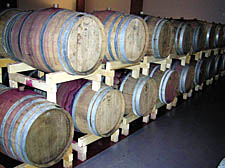|
|
 |
| |

New oak wine barrels in a modern winery |
Bring out the oak barrels of flavour
Oak barrels are almost as vital in wine-making as grapes
LOVE and marriage or the horse and carriage, you can’t have one without the other, sang Frank Sinatra in the mid 1950s. The song was of course wrong.
Around the same time a new and now seemingly inseparable partnership – wine and wood – was beginning to blossom. Their combined taste has come to dominate most bottles of wine. Oak trees often provide a large part of a supermarket wines flavour. Nearly every red and many whites – particularly Chardonnay – owe some or even most of their flavour to contact with oak.
Oak barrels were originally used for storing and transporting French wines to international markets. Nineteenth-century Spanish wine-makers – tired of playing second fiddle to the French – began to experiment by aging their wines in oak barrels. The result was a wine sensation – Rioja.
Wealthy Spaniards, clamoured to buy the new wine. Long aging in oak barrels allowed difficult wines to develop new flavours, additional structure, and remain fresh.
As in Rioja a hundred years before, pioneering post war Californian wine-makers set out to create an upmarket wine. Unlike the wine-makers of Rioja who used their local Spanish Tempranillo grape combined with Bordeaux wine making methods, the Californians choose the vines of Burgundy – Chardonnay and Pinot Noir – and copied its wine-making style, lock, stock and French oak barrel.
The experiment was a huge success and the new American Chardonnay was considered to have Burundian characteristics. But French barrels are expensive and many Californian winemakers preferred cheaper American oak.
These wide grained barrels imparted far stronger oak induced flavours. Australian, South American and east European wine makers soon copied the American example.
Recently the French – including a few Champagne producers – have began oaking previously unoaked wines and are labelling these unoaked wines – even when made in a modern temperature controlled stainless steel vat – traditional.
Modern wine-making has raised oak to a position where it shares equal importance with the grape.
A new generation of wine drinkers consider heavily oaked wines normal, and often find – even well made – unoaked wines to be thin and lacking in flavour.
French barrels are the most expensive and impart spice, vanilla and relatively subtle savoury flavours.
American oak barrels impart similar but stronger and often sweeter attributes and tend to dominate all except the more powerful tasting wine.
Slovakian barrels are making a comeback following the collapse of communism and are considered a cheap alternative.
Bargain basement oaking is achieved by bolting oak panels to the inside of a stainless steel vat or dunking a giant ‘teabag’ full of oak chips into the wine. This last method is increasingly used by home wine makers.
New oak imparts the most taste, when used a few times barrels lose their ability to flavour. In this age of rampant experimentation many winemakers blend wine from new and used barrels to produce the finished wines, others barrel oak the wine twice, using two sets of barrels.
How the barrels are toasted – burning the inside of the barrel – prior to use also affects the flavour of the wine.
|
 |
| |
| |
|
 |
|









